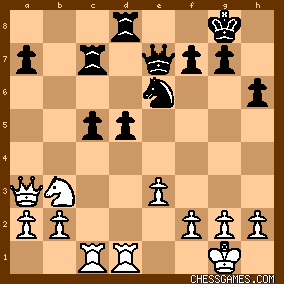Eyal: From Dennis Monokroussos' commentary:
<22.Nb3 Ne6

click for larger viewBoth pawns are attacked, both are defended. Now what? Well, hanging pawns sometimes advance, and that can be good or bad. The bad version is when a pawn advances and White gets to securely blockade the square in front of the other one (e.g. Black plays ...c4, White gets the d4 square). The good version is when Black gains something dynamic with an advance (e.g. ...d4, gaining a passed pawn, or opening the a8-h1 diagonal when there's a Bb7, or freeing f4 for the Black knight, etc.). 23.h3 Rc6 24.Rc2 d4!? 25.exd4 [25.Nxd4!? Rcd6 26.Rxc5 Nxc5 27.Qxc5 might not have been a bad choice. White gets two pawns for the exchange and a very strong knight on d4. That should be enough for at least equality, especially since a well-timed Nf5 could bother Black's king.] 25...Rcd6 26.d5?! Rxd5 27.Rcd2 Rxd2 28.Rxd2 Nd4!

click for larger viewA very strange position. Viewed statically, White's in very good shape, but his pieces are vulnerable to tactical possibilities: 29.Nxd4?? Qe1+  ; 29.Rd1?? Ne2+ ; 29.Rd1?? Ne2+  (or 29...Nf3+ ); 29.Qxc5?? Qxc5 30.Nxc5 Nf3+ 31.gxf3 Rxd2 (or 29...Nf3+ ); 29.Qxc5?? Qxc5 30.Nxc5 Nf3+ 31.gxf3 Rxd2  ; 29.Qa5 might be worth considering, though, protecting the Rd2 and hitting the Rd8. ; 29.Qa5 might be worth considering, though, protecting the Rd2 and hitting the Rd8. 29.Qa6 Overprotecting e2.
29...Rd5! More neat tactics. White's rook and knight are still paralyzed, and now Black has a nasty little threat to boot. 30.Qf1 [30.-- Qe1+ 31.Kh2 (31.Qf1 Nf3+ 32.gxf3 Rg5  + ) 31...Nf3+ 32.gxf3 Rg5 and wins, e.g. 33.Qc8+ Kh7 34.Qg4 Rxg4 35.hxg4 c4 + ) 31...Nf3+ 32.gxf3 Rg5 and wins, e.g. 33.Qc8+ Kh7 34.Qg4 Rxg4 35.hxg4 c4  ] ] 30...Re5 Another threat.
31.Rd1? Understandably, White errs under the pressure. [31.Qd3!= ] 31...Nxb3 32.axb3 Re2 Black's pieces dominate, and he's probably going to make off with an extra pawn. 33.Rc1 g6 34.g3 Qe4 35.Rc4 Qe6 36.Rc1 Rxb2 37.Rxc5 Qxb3 Mission accomplished. Black has a very safe extra pawn, and in his capable hands the technical task is but a matter of time.> (http://chessmind.powerblogs.com/fil...) | 




